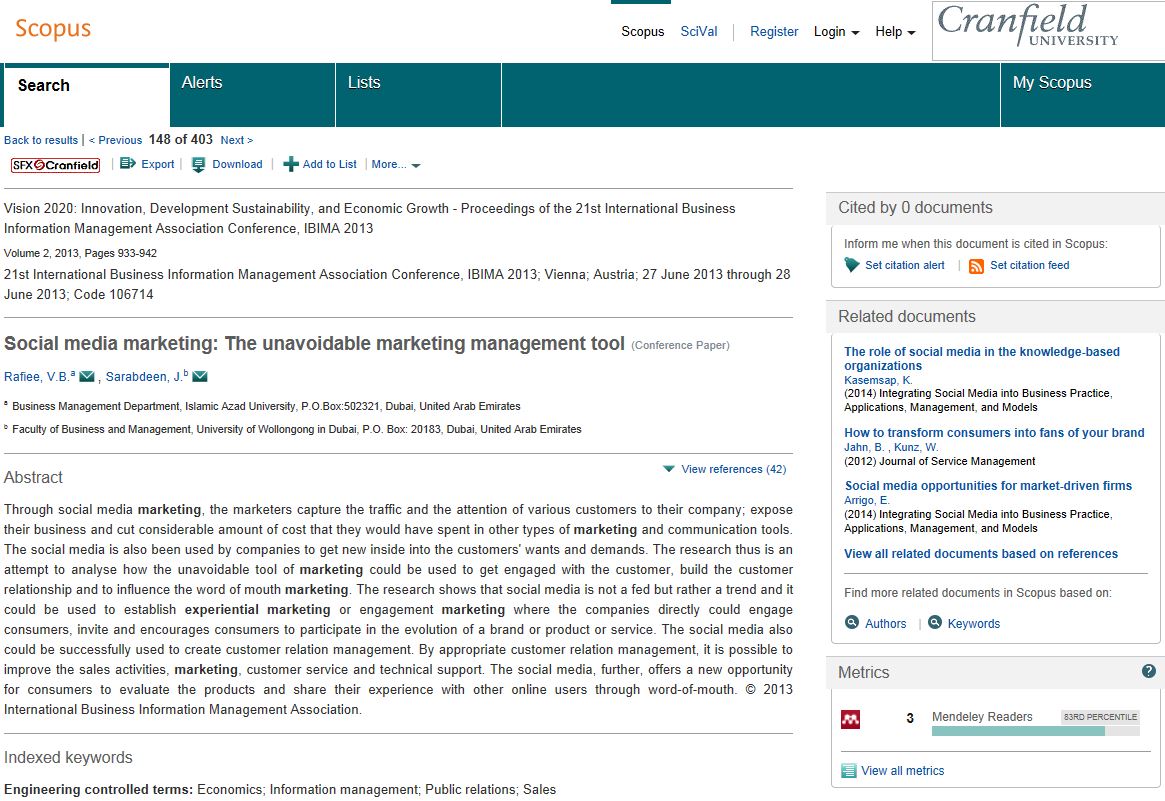How do I reference a conference paper… in the Cranfield Author-date style?
17/05/2016

As we enter thesis season, many of you may find that you are using conference papers in your research. Just like books and journal articles, these need to be referenced at the end of your work and, just to make life a bit more interesting, conference paper references have their own specific format, making them different to those for other articles or reports.
Let’s look first at the information you need to include to reference a conference paper in the Cranfield author-date style:
- Author(s) of paper (surname, initials)
- (Year of publication)
- ‘Title of paper’,
- Title of Conference: Subtitle.
- Location and date.
- Place of publication: Publisher,
- Paper number (if available),
- Volume (if known),
- Page range.
Here’s an example of a conference paper I found in my search:
The elements listed above will all come together to form the reference below:
Rafiee, V. B. and Sarabdeen, J. (2013) ‘Social media marketing: The unavoidable marketing management tool’, Vision 2020: Innovation, Development Sustainability, and Economic Growth – Proceedings of the 21st International Business Information Management Association Conference. Vienna, Austria, 27-28 June. Vienna: IBIMA, Vol. 2, pp. 933-942.
As you can see from the screenshot, I sourced this conference paper from Scopus. If your paper is available online, then you need to add in the URL and the date on which you accessed it, as you would do with any online source. These are added to the end of the reference, as shown here in blue.
Rafiee, V. B. and Sarabdeen, J. (2013) ‘Social media marketing: The unavoidable marketing management tool’, Vision 2020: Innovation, Development Sustainability, and Economic Growth – Proceedings of the 21st International Business Information Management Association Conference. Vienna, Austria, 27-28 June. Vienna: IBIMA, Vol. 2, pp. 933-942. Available at: http://www.scopus.com/ (Accessed: 25 January 2016).
In-text citations:
Where you make reference to this item in your text, follow the normal ‘name and date’ conventions and simply follow any mention with (Rafiee and Sarabdeen, 2013) or a variation thereon, remembering to add a page number where a direct quotation is involved.
As always, if you have any questions about referencing or citations, please contact the contact the Library service.
Feature image from Pixabay. Available at: https://cdn.pixabay.com/photo/2016/06/01/06/26/open-book-1428428_960_720.jpg
Categories & Tags:
Leave a comment on this post:
You might also like…
Introducing…. BankFocus (Orbis)
For anyone researching the financial sector, BankFocus is a great place to start, providing financial and company data for finance institutions and companies from across the world. The service allows you to search for a ...
The Implications of US Tariffs on global supply chains
US President Donald Trump's new tariff policies announced on April 2, 2025 are expected to cause significant disruptions to the global supply chains, affecting multiple sectors and countries. A simple mathematical equation uses a country’s ...
Mastering the art of revising your writing
You’ve done the research and written your first draft. Now it’s time for one of the most crucial jobs as a writer - revising your writing to ensure your reader does not have to work ...
A ‘hands-on’ take on warehouse design as part of my Logistics and Supply Chain MSc
As part of my core module for my Logistics and Supply Chain Management MSc, I had the amazing opportunity to work on a warehouse design project a few weeks ago. The problem statement for ...
Thinking about your literature review?
As part of your PhD or Master’s thesis, you will probably have to write a literature review. A successful literature review will offer an analysis of the existing research in your field, demonstrating your understanding ...
A beginner’s guide to sourcing a company beta
Beta is the measurement of a company’s common stock price volatility relative to the market. If you’re trying to find a current beta for a company there are a number of places to look. These ...







